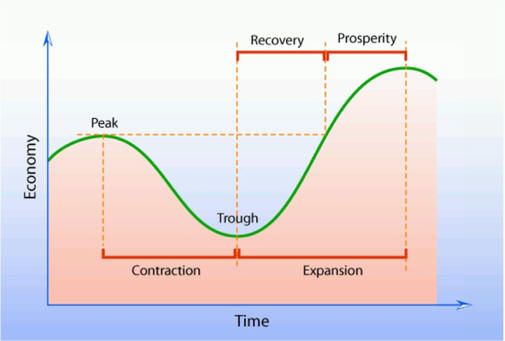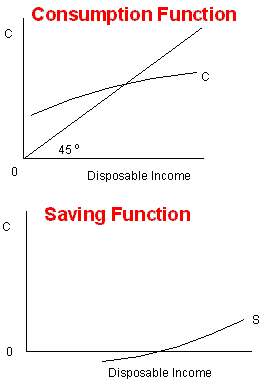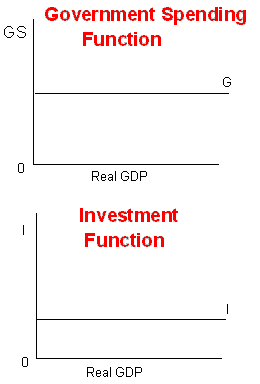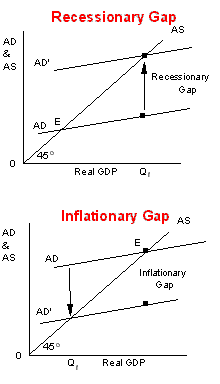
Macroeconomics Review #2
Chapters 8-14
Understanding Total Economic
Activity
Retired teacher, suggestions to
antonw@ix.netcom.com
Thanks for using! Walter
Please
Share updated
7/1/24
The Business Cycle Ch 9
Macro Equilibrium Ch 10
Competing Macro Theories and Issues Ch 12
Keynesian Economics: An Expanded Review Ch 12
Money, Banking, and the Creation of Money Ch 13
AP 15 Min Macro Review Video
More Free Econ Stuff
Use
Economics Video Lectures
to Quickly review important concepts
Measuring Total Economic Activity Review
Chapter 8
A. Gross domestic product (GDP)
1. The sum of all the goods and services
produced within an economic unit (country, state)
within a
period of time (normally a year)
2. Excludes non-productive transfers
a. Stock market sales
b. Working at home
c. The "Underground
Economy" (unreported taxable income)
3. Two approaches to calculating GDP
a. Expenditure
approach
1.
GDP equals Personal Consumption plus Business Investment plus Government
Spending plus Net Exports (exports minus imports)
2.
GDP = C + I + G + XN
3. I is gross investment which is new capital
and replacement capital (depreciation)
4.
Q1
2010 GDP 3rd revision - 2.7%
from the economicpopulist.org blog
give some
current information on the national income accounting calculation process.
b. Income approach
1.
GDP equals Rent plus Wages plus Interest plus Profits plus Depreciation plus
Indirect Business Taxes
plus miscellaneous
2.
GDP = R + W + I + P + Acc. Dep. + Ind. Bus. Taxes + Misc.
B. Interpreting national income account data
1. Comparing data over
time requires adjusting for inflation, population
increases, and number of people working.
2. National income accounts
do not consider leisure time.
3. Positive and negative
effects of economic activity upon the environment are not measured by national
income accounts.
C. Money vs. real GDP (taking inflation out of financial data)
1. A Price Index measures
price changes for a basket of commonly used goods over a period of years.
a. One year is chosen as
a base year, set equal to 100 and years before and after are expressed as a
percent of the base year.
b. For convenience all
index calculations are multiplied by 100 allowing the percent sign to be
dropped.
c. Two important
indexes are the Consumer Price Index (CPI) and the Producer Price
Index (PPI) which respectively
measure the inflation associated with consumer and producer goods.
2. An index can be used to
determine whether someone's salary, a consumer good, and other items of interest
have changed
more or less than inflation.
a.
Nominal salary is salary measured in current dollars.
b. Real
salary is salary adjusted for inflation.
3. This example uses actual consumer
price changes and 1982 as the base year (PB).
The item of interest could be
someone's
salary, the price of a new car, etc. (PC is price in current year).

The Business Cycle Review
describe the business
activity over time.
View Entire Chapter 9
A. Recession: commonly accepted definition is two
consecutive quarters of negative
growth in Real GDP.
B. Why business activity fluctuates
1. Inventory Recession:
Excessive optimism causes inventories to over expand and
eventually they must be worked down causing a recession.
2. Rolling Recessions:
Economic downturn is limited to areas or sectors of the economy.
3. Innovation Cycle:
railroads, computers, bio-technology
4. Political Events: wars,
international trade
5. Misuse of Monetary and Fiscal
Policy: government creates and/or borrows an
incorrect
amount of money
6.
Non-cyclical Fluctuations
a.
Seasonal variation: Christmas buying rush, spring construction
b.
Long-Term Secular Trends: the expansion or contraction in the level of
economic
activity over a long period of years (the dark ages, the industrial revolution)
7. Durable Goods have a long
useful life (houses, equipment, etc.) Sale of durable goods
contract
substantially during a recession as their purchase may be easily postponed.

C.
Leading, coincidental, and lagging indicators
are measures such as the
unemployment
rate, which respectively change before, with or
after general economic activity. Economists
use to predict future economic activity.
D.
Unemployment Types and special topics
1. Frictional is
caused by time lags in the operation of labor markets.
a.
Workers are between employment because they have been fired, are changing
careers, are seasonal workers, have been temporarily laid off, etc.
b.
Short-term, inevitable, temporary, and is eliminated with time.
2. Structural is caused by
changes in consumer demand and technology.
a. Result
is an oversupply of workers with a particular skill.
b. This unemployment is often
concentrated in a particular area, associated with a
particular industry,
and is
often permanent.
c. Increased economic activity
will not decrease this type of unemployment as training
and/or
relocation are
required.
d.
Happened in the 1970's and early 1980's as consumers decided to buy small foreign
built cars
and other products produced
in the Rust Belt. Now it is happening because
NAFTA and foreign competition
are causing industries
to restructuring is
needed because of foreign competition.
3. Cyclical
a. Caused by a lack of total demand
at the end of an economic expansion
b. Temporary
c. Recession of the early 1990's was due to a drop in demand caused by a debt
buildup in the
1980's by individuals, businesses, and the federal government.
Apprehension caused by high
structural unemployment of both blue and white
collar
workers slowed the recovery.
d. Recession of 2001 was caused
by debt build up of individuals resulting from the
long period of
prosperity and
the stock market bubble, excess capital investment
caused by Y2K and
internet optimism, and
September 11.
e. Great Recession of 2008-09 was caused by the end of an excessive
building
boom
compounded by a banking and stock market crisis.
4. Special
topics
a. Natural unemployment (frictional + structural unemployment)
is
usually 4% to 6%
of the labor force
b. Full employment is when cyclical unemployment equals zero
c Okun's Law: a 1% increase in cyclical unemployment will cause a 1% increase in
cyclical unemployment will cause given a 2.5% annual drop in GNP
1) GNP change = 2.5
(unemployment rate change)
2) If unemployment goes up 2% as it did in the 1990-91 recession then the
drop in
GNP would be 2.5 X 2% or 5%.
3). Cost to a 6 trillion dollar economy of 250 million people
(5% X
$6,000,000,000,000) / 250,000,000 = $1,200/person/year.
E. Inflation is an increase in prices
as measured by a price index such as the
consumer producer index, CPI and
the Producer Price Index, PPI.
1. The PPI measures the
change in wholesale
prices.
2 The PPI is a
leading indicator for CPI as
wholesalers can usually pass price
changes on to retailers who pass them to consumer.
a. Recent increases in
foreign competition made passing price increases on difficult.
b. The internet
had the same kind of affect in the late 1990's.
3. The inflation rate for a year when a basket of
consumer goods increase from
$400 to $420 would be calculated as follows.

4. Causes of inflation
a. Demand-pull inflation
1. Increases in C + I + G + XN will cause GDP to increase.
2. As the economy nears full employment, the prosperity caused by high
employment increases demand and put upward pressure on prices.
3. When this happens, the
economy is said to be overheated.
b. Cost-push inflation
1. As the economy approaches full employment factor resources become
scarce
allowing their owners to increase prices.
2. Supply-side shocks can cause high resource prices even if demand for
resources is low, i.e., OPEC's two oil embargoes of the 1970's
5. Economic effect of inflation
a. Both income and resource allocations are affected by inflation
as the market tries
to
adjust to the loss in value caused by inflation.
1. High gas prices in
the 1970's caused a switch to small cars and many people
bought wood stoves.
2. Low gas prices in the
1990's made RV's less expensive to run.
b. Debtors (homeowners, businesses, government) are helped by high inflation
because they pay back with dollars worth less than those
borrowed.
c. Creditors are hurt by inflation as they are paid
back in less valuable dollars.
d. Those on a fixed income are also hurt by the
cheaper dollars.
d. Cost-of-Living Increases (COLA's) were instituted in the 1970's
to negate
the severe effects of that period's high inflation.
e. Deflating GDP
1. Inflation can be taken
out of growth in GDP by expressing later year production
at earlier year prices.
2. In the following
chart, letters Q, P and T are quantity, price per unit
and total respectively.
Macro Equilibrium
Chapter 10
exists when
the demand and supply variables affecting total economic
activity are in balance
and under no pressure to change.
A.
Macro equilibrium exists even though
the more slowly changing variables affecting long-term
activity are still
in flux. Said
long-term activity is called a long-term secular trend.
B. Aggregate demand, AD,
is
a schedule matching the Real Gross Domestic Product a country purchases at
various price levels.
1. As prices drop, the amount of
real gross domestic product purchased (AD) increases.
AD = C + I + G + XN
2. Like all demand curves, AD increases to the right
and decreases to the left
3. Price level is the key determinate of aggregate demand. Holding
non-price level determinants constant
yields the
following analysis of why price levels and aggregate
demand are inversely related.
a. Interest rate effect
1. If the price (inflation) is low, interest rates will be
low causing
consumption and investment to be high
increasing AD.
2. This is especially true now that home mortgages are easily refinanced at
lower interest rates.
b. Real asset balance effect as low inflationary expectations
cause people think their past accumulations
(savings) will maintain their value. causing people to
spend more which increases AD.
c. Low domestic inflation relative to foreign inflation results in low-priced
exports selling better which
increases AD
d. High price levels will bring opposite results
4. Non-price level determinants of aggregate
demand and
their determining characteristics
a. Consumption (C). Increased expectation of wealth caused by more overtime, debt decreasing
by
refinancing a home at lower
interest and taxes going down all increase consumption.
b. Investment (I) Increased profit expectations, decreased business
taxes, low excess capacity, and
positive technology outlook
all increase investment. .
c. Government Spending (G)
d. Net
Exports (XN) (exports minus imports) are determined by economic activity abroad
and exchange rates
5. Price level and non-price level factors
together determine aggregate demand which interacts with aggregate
supply to determine total economic activity.
C. Aggregate Supply
is a schedule of the amounts of Real Gross Domestic
Product companies are willing to
produce at various
price levels.
1. Holding non-price
determinants constant yields
the following analysis of how different price levels affect AS.
2. Keynesian Range: increases in AD increase real GDP and prices do not
change
3. Intermediate Range: both prices and real GDP change
4. Classical Range: increases in AD increases prices and real
GDP does not change because full
employment exists
5.
Non-price factors affecting aggregate supply factor
price decrease, productivity increases and
increased domestic and foreign tranquility all will increase AS

 1.
Laffer Curve
1.
Laffer Curve






